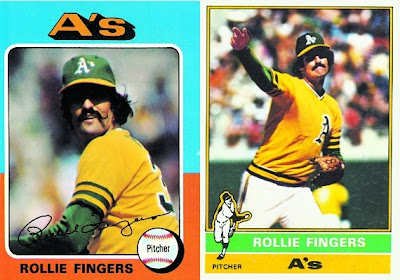Yeah, I'm Talking to the Ball. What of It?
In 1976, Big Bird left Sesame Street for the comfort of the mound where he often gave the ball a pep-talk before he sent it on its fast and nearly un-hittable path to the waiting catcher's mitt 60 feet and six inches away.
Mark Fidrych was known to many as simply, "The Bird," for his comical resemblance to our feathered friend from Sesame Street. Fidrych's tall, lanky frame was topped with a mop-like, blond pile of hair. He enjoyed just two complete seasons in the majors - and only one that was entirely successful - but left in indelible mark on the big leagues.
 |
| 1977 Topps |
Along the way, Fidrych captured the hearts of the country with his unusual antics on the mound. He was known to get on his hands and knees and groom the mound, freeing it of cleat marks, before his was willing to pitch from it. He often talked to himself, looking the ball in its little seams before letting it fly. He often strutted around the mound after every out, talking to himself, the ball, the dirt. He was known to aim the ball at the catcher's mitt, like one aims a dart, and perhaps most interestingly, he often refused to you use certain balls because they "had hits in them." He demanded that those balls be removed from the field.
My dad wasn't a Tigers fan, but I can remember him laughing at the TV when Fidrych was on. The 1977 Topps card pictured at the right was one of the first "big find" cards that I pulled from a pack. I remember rushing in to show my "BIRD CARD" to my dad. You'd have thought I had stumbled upon the Holy Grail.
However, as storied as Fidrych's 1976 season was, it was not to last. During spring training the following year, he was shagging fly balls with some teammates when he injured his knee. Later that season, while pitching a game, he tore his rotator cuff, though it would not be diagnosed as such until years later. While pitching with a terribly injured arm, he stumbled to a 6-4 record in 1977, then struggled to even pitch in a big league game between 1978 and 1985. He spent much of that time in the Tigers and Red Sox farm leagues, trying to reclaim the potency of 1976 whirlwind season, but it was not to be.
 |
| Sports Illustrated, June 1977 |
Fidrych last appeared in a major league game in October 1980, finally retiring in 1985 at the age of 29. He finished his career with a modest 29-19 record, an ERA of 3.10 and 170 strikeouts - pedestrian numbers for a pitcher who for a year, captured the hearts of an entire country. Fans of Fidrych's called themselves "Bird Watchers" and to this day, Fidrych's retro jersey can be spotted on Tigers fans in Detroit's Comerica Park.
After hanging up his cleats, Fidrych lived in Northborough, MA where he worked as a contractor, hauling gravel and asphalt. He also worked weekends in his mother-in-law's diner.
Tragically, The Bird died April 13, 2009 while working on a dump truck used for his business. Authorities said it appears that Fidrych's clothing became tangled in the truck's power takeoff shaft, causing him to suffocate. He was 54.
About Fidrych's three key baseball cards:
- 1977 Topps, #265 (pictured above) - This is Fidrych's official rookie card and currently has a Beckett book value of $3.00, while the 1977 Topps cloth sticker equivalent comes in at just $5.00.
- 1978 Topps, #45 - This card has a current Beckett value of $2.50.
- 1979 Topps, #625 - This card has a current Beckett value of $2.50.

.jpg)
.jpg)







.jpg)

